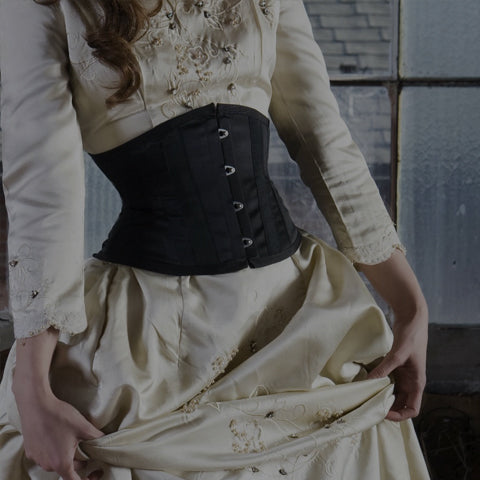Men's Victorian and Edwardian Shirts Pattern
by Laughing Moon Mercantile
This pattern offers an incredible range of styles and sizes! No matter what your shirt need is this pattern will solve it. Sizes range from 14" neck to a 20" neck and sleeve lengths go from 32" to 38" with cut and fold lines for going still longer or shorter. The wide range of sizes makes cutting out the pattern a challenge at some spots. I recommend you take a fine "high lighter" pen and trace off the lines you want so they are easy to follow. The pattern includes 3 shirt styles, 7 collar variations both attached and detachable and 4 cuff styles… and 12 tie styles!!! You can mix and match however you please.
Historic information is supplied in the pattern to help you know which collars and cuff to choose if you want a historically accurate shirt. Read the pattern pieces carefully, with so many options it is easy to get the wrong pieces. I chose to make what I think of as a "bib front" tuxedo shirt. In this pattern the part I call a "bib" is called a "bosom".
 |
|
|
The shirt |
Bib/bosom detail |
|
This is shirt style "B" with a detachable "Wing Collar" and detachable "Duane" cuffs, both collar style and cuffs are from the early 1900's. I use "pique" cotton for the bib and cuffs, it could also have been used for a bow tie. Bibs were heavily starched and to get this effect I used heavy sew in interfacing, it worked perfectly! I also used it in the collar and cuffs and with excellent results. A lighter interfacing would be better in the collar stand as it would decrease the bulk that the collar stud has to go through. So I do not suggest using the same interfacing in the collar stand, the medium weight sew in interfacing would likely be fine.
|
|
 |
 |
|
Shirt cuff detail |
Duane detachable cuff detail |
Instructions are very explicit and I have little to add to them, there are three pages of sewing instructions, two of cutting layouts and one with pertinent historical information including a "cooked starch recipe" for those who are keen to "do it right". Starching garments tends to help them maintain their shape despite packing, even today there are business men who want starched shirts for travel as they can pull them out of their case and the shirt looks great.
I did do a couple of things differently. I serged most seams, rather than flat felling. I am not a purist and am always more concerned with the quality of the pattern pieces (do they fit) and the depth of instructions (are they complete)…even I do not follow them all. The only other changes I made were in the "bib"/"bosom" building section -steps #9 and #10.
Step 9 requires the finishing of the center front edges of the "bosom", the instructions say to create a narrow hem. Because I was using interfacing for the whole bib/bosom I cut two pique bib fronts and two interfacing bib fronts, I pinned the interfacing to the pique with right sides together and stitched down the front edges with ¼" seam allowance. I pressed the stitching, then pressed the seam open, folded the two pieces back into place with wrong sides together and pressed the seam flat. I then pressed along the fold line to create the placket This finished the front edge, it also meant there are two layers of interfacing in the placket which is a bit bulky but the shirt studs fit and it adds to the stiffness of the front.
Step 10 is the application of the bib/bosom to the shirt this went perfectly! The only thing I did differently was I made one set of buttonholes (on the left bib front) before attaching the bib. It was less awkward to do them before I had sewn the bib on. I did the second set of buttonholes (on the right bib front) after sewing the bib on as they have to line up exactly and I used the first buttonholes as a guide for the second ones.
These are the only changes I made in the whole pattern.
PATTERN DETAILS, LAUGHING MOON MERCANTILE PATTERN #107, VIEW B






Leave a comment
All comments are moderated before being published.
This site is protected by hCaptcha and the hCaptcha Privacy Policy and Terms of Service apply.